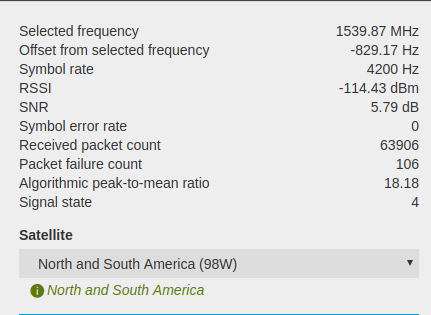@Syed I have built a receiver using an RPI3, SDRx and passive patch antenna. I bought the last two from Outernet. But I am receiving max. 1.5dB very rarely, and not for much longer than a few seconds. Sometimes, the SNR becomes negative. Please help. The receiver is based in London, United Kingdom (i.e. Alphasat 25E). I have tried all sorts of orientations and tilt angles, but to no avail. I have tried it both on ground level and on the 17th floor of a block of flats near a window and on a balcony. I have attached a screenshot of the Outernet Librarian Tuner Settings page (NB it changes frequently so may not be accurate). My signal state etc. is all 0. I have also tried using metal box, aluminium foil etc. Something is not quite right!
Alphasat changed frequency to 1546.25 MHz some weeks ago.
Still no success.
Wow … zero, zip, nada for signal. Let’s look at the hardware carefully. Can you take a picture of your setup?
Also, what software and version are you using?
@london
Here’s what my tuner settings look like in my Raspberry Pi setup. [RPi, SDRx and air gap patch]
I’m in the Seatlle area.

Let’s get yours working correctly.
–Konrad, WA4OSH
rxOS 3.1, Librarian 5.0dev1
Currently the setup is inside with a very good view of the sky. Didn’t work much better outside (tested on grass, as well as 15th/17th floor balconies).
OK …
Setup looks OK…
Air gap antenna, SDRx, that is an RPI3 in the red and white box, right?
You will still need a memory stick for storing your data, but this is not something that needs to be solved now.
Software looks good.
Then, let’s divide and conquer…
Is there a white light on the SDRx? If not, I would question is is the SDRx or the RPI3?
Did you try the SDRx on another USB port?
Does the SDRx work on your laptop with SDR# for example?
It should turn on the white light and run just like a RTL-SDR dongle.
What do you see on the waterfall display?
Let’s see how you answer this batch of questions. Then we’ll figure it out.
–Konrad WA4OSH
Yes, there is a white light on the SDRx. Have tried other USB ports without success. Seems to work on laptop but still not great SNR. Have attached screenshot of waterfall display.
@London
So if you are getting a white light, the SDRx is getting power from its USB host. Then, I see you did the SDR# test on your laptop with the SDRx. This should have yielded some signals. It looks like the SDR# is able to “see” the RTL-SDR on the SDRx board. However, we are not getting a lot of signal from the SDRx.
The antenna is so simple that I’m doubting that it’s the antenna’s fault. Do a visual inspection…
- Is the coax bent or broken anywhere?
- Any cold or intermittent solder joints?
Do you have a regular RTL-SDR dongle? If so. you should be able to pick up all sorts of things with the patch antenna, the RTL-SDR and your laptop, specifically around 1090 MHz (ADS-B), perhaps some other activity in the lower half of the L-Band (1 GHz to 1.5GHz). It this works, then you can rule out the antenna and with confidence say it’s the SDRx board.
The LNA’s are very sensitive to electrostatic discharge (ESD). You may have blown the LNA. I would prove that on a bench by injecting a signal right behind it, before the SDR.
–Konrad, WA4OSH
Also check to make sure the center pin in the SMA connector between the antenna and the SDR is present. I once ran into a problem with a CHIP/SDR/Antenna where the center pin broke off. Ken
@Syed There aren’t any visual signs of damage. And I don’t have a RTL-SDR dongle. So, I will probably give it one more go in a different location, or otherwise I will exchange the items with Outernet. Do you have any better ideas Syed (since you are an ultimate expert)? If not, please clarify the return policy in this particular case.
@london
I’m only a visitor to this board. You will have to deal with a bad SDRx board with Outernet or @Syed.
Antenna orientation. I’m assuming you are in Europe. Use this tracker to locate Alphasat:
Search satellites using N2YO
Notice it gives you the azimuth and elevation. Note that the declination in Europe is minimal. It’s a real problem here in the Pacific Northwest.
Find an area with clear and open sky to the “bird”.
–Konrad, WA4OSH

